Medicine > TEST BANKS > Test Bank: National Physical Therapy (NPTE) Final Exams Questions & Answers Explained with Rationale (All)
Test Bank: National Physical Therapy (NPTE) Final Exams Questions & Answers Explained with Rationales, Rated 100%
Document Content and Description Below
Test Bank: National Physical Therapy (NPTE) Final Exams Questions & Answers Explained with Rationales, Rated 100%-You are testing a patient's deep tendon reflexes during an evaluation for low back pai... n in outpatient physical therapy. Which of the following is MOST likely to be consistent with a false negative patellar reflex? A. 2+ reflex and the patient has a confirmed L4 nerve root syndrome B. 1+ reflex and the patient has a confirmed S1 nerve root syndrome C. 3+ reflex and the patient has a confirmed L4 nerve root syndrome D. 2+ reflex and the patient does not have L4 nerve root syndrome - A. 2+ reflex and the patient has a confirmed L4 nerve root syndrome 2+ reflexes are considered normal according to the reflex grading system. A false negative indicates that the test is normal but the patient has pathology. The correct answer states that the reflexes are normal but the patient has a pathology that affects the L4 nerve root. A PT examines a pt complaining of tingling into the 4th and 5th digits with muscle wasting over the hypothenar eminence. The PT suspects ulnar neuropathy and decides to examine the integrity of the nerve. Which of the following testing procedures would be the best? A. Have the pt flex both wrists while holding them for one minute B. Have the pt make a fist around the thumb and perform ulnar deviation C. Have the pt grasp a piece of paper between their first and second fingers while the examiner pulls the paper and monitors the first finger D. Have the pt perform extension of the 3rd digit of the hand against examiner resistance - C. Have the pt grasp a piece of paper between their first and second fingers while the examiner pulls the paper and monitors the first finger This is a test for the Froment's sign which checks the ulnar nerve. If the pt flexes their thumb when resisting the pull they may have a problem with the ulnar nerve. A 48-year-old male patient reports of SOB and swelling in LE's. During the baseline examination, the PT examines patient's heart sounds before starting an exercise program. Which valve is being auscultated at #5 in the picture? A. Tricuspid valve B. Pulmonary valve C. Mitral valve D. Aortic valve - C. Mitral valve "All Physical Therapists Make $2245 per week" Aortic- 2nd intercostal on R Pulmonary- 2nd intercostal on L Tricuspid- 4th intercostal on L Mitral- 5th intercostal on L A low back pain patient's Oswestry Disability Questionnaire score was 18 points. Four weeks later, the score was 50 points. Which of the following is the BEST option for the physical therapist? A. Continue PT until the pt returns to a score of 60 B. Discharge the pt as there is an improvement C. Document the improvement and start HEP D. Ask the pt to have a physician consult - D. Ask the pt to have a physician consult The higher the score, the more disability they have. So this patient has worsened over the last 4 weeks. A 44 y/o female pt arrived to a clinic after sustaining a fall involving a hand/wrist injury. Upon examination, the PT observed the radius dislocated in a volar direction. Which of the following conditions would MOST likely match this description? A. Smith's Fx B. Colle's Fx C. Scaphoid Fx D. Dinner fork deformity - A. Smith's Fx Colle's Fx- the radius goes in the DORSAL direction Dinner fork deformity- this is another name for Colle's Fx A PT is evaluating a 34 y/o female pt with a vague diagnosis of LBP. The pt displays a positive Thomas test. Which sub phase of the gait cycle will MOST likely show limitation in the hip ROM? A. Loading response B. Initial contact C. Midstance D. Terminal stance - D. Terminal stance The hip flexors will try to stop the hip from going into extension A pt arrived at an outpatient clinic with chief c/o LBP. Upon further evaluation, the pt mentioned taking calcium channel blockers. Which of the following is MOST LIKELY accurate regarding the medication effect on the cardiovascular system? A. Constrict coronary blood vessels B. Dilates coronary blood vessels C. Activates coronary vasospasms D. No effect towards coronary vasospasms - B. Dilates coronary blood vessels C and D- calcium channel blockers INHIBIT coronary vasospasms Which of the following is NOT an expected sign seen in a pt with facial nerve (CN VII) palsy? A. Hyperacusis B. Absence of sensation in the anterior 2/3 of the tongue C. Absence of corneal reflex D. Decrease lacrimation - B. Absence of sensation in the anterior 2/3 of the tongue Rationale: Sensation in anterior 2/3 of the tongue is by the trigeminal nerve and not the facial nerve. Facial nerve is for TASTE on anterior 2/3 of the tongue. A- defined as the collapsed tolerance to normal environmental sounds. Facial nerve controls the excessive movements of the stapedius bone and dampens the sound and its injury can cause hyperacusis. A 60 y/o male pt c/o a shock-like and stabbing sensation running through his jaw line which has become frequent and excruciating lately. He says that the episodes occur usually when he goes out in cold weather or when shaving or brushing his teeth. The therapist suspect a possible cranial nerve inflammation. What is the suspected condition and the cranial nerve affected? A. Bell's palsy; CN 7 B. Trigeminal Neuralgia; CN 7 C. Bell's palsy; CN 5 D. Trigeminal neuralgia; CN 5 - D. Trigeminal neuralgia; CN 5 A patient who is 3 months post right ankle fracture has an AROM of 0-30 degrees of DF and 0-10 degrees of PF. To restore motion required for normal walking, which of the following joint mobilization techniques should the PT perform? A. Anterior glide of the talus B. Lateral glide of the calcaneus C. Medial glide of the calcaneus D. Posterior glide of the talus - A. Anterior glide of the talus PF is limited so you are restoring that. Always stick to your plane for glides. You can rule out B and C because they are not in the correct plane for PF. With PF you are moving down and posteriorly. The ankle is convex on concave so you know that roll and glide are opposite. So since the roll is posterior you know the slide is anterior. A PT is testing the active shoulder ROM of a 45-year-old female patient. The PT asks the patient to move the shoulder to full medial/internal rotation. During medial rotation at the shoulder joint (GH joint), the humerus will slide: A. Anteriorly B. Superiorly C. Inferiorly D. Posteriorly - D. Posteriorly For medial rotation you will roll anteriorly. This is a convex on concave movement so slide is opposite and in the posterior direction. A patient demonstrated painful ROM in horizontal abduction movement during ROM examination of shoulder. Which of the following joint mobilization techniques is MOST appropriate for the patient? A. Large amplitude oscillations performed at the beginning of the ROM in an anterior-inferior direction B. Small amplitude oscillations into tissue resistance up to the limit of available motion in a posterior-superior direction C. Large amplitude oscillations within the available ROM in an anterior-inferior direction D. Small amplitude oscillations into tissue resistance at the limit of available joint motion in a posterior-inferior direction - C. Large amplitude oscillations within the available ROM in an anterior-inferior direction With horizontal abduction you are rolling posteriorly so you must glide anteriorly so that rules out B and D. Now you must consider the different grades of mobilizations. You know that you will use either grade I or II because the pt has pain. Grade I is small amplitude so you know it must be grade II. C describes a grade II mobilization. A 39 year old comes to an outpatient clinic complaining of neck problems. Which of the following exercise combinations is MOST appropriate for a patient who has a forward head posture? A. Strengthen the deep cervical flexors and stretch the SCM's and upper cervical extensors B. Strengthen the deep cervical flexors and SCM's and stretch the upper cervical extensors C. Strengthen the cervical extensors and stretch the SCM's and deep cervical flexors D. Strengthen the cervical extensors and SCM's and stretch the deep cervical flexors - A. Strengthen the deep cervical flexors and stretch the SCM's and upper cervical extensors When your head is forward C3-C7 will flex and C1-C2 will be extended. Think of the upper cross syndrome for a forward head. The deep cervical flexors and lower trap/serratus anterior are weak. The SCM/pecs and upper traps/levator scapulae are tight. A 39-year-old comes to an outpatient clinic complaining of hip problems. The PT notices a drop of the left hip during right midstance. The MOST LIKELY cause of this impairment can be the injury of: A. Right inferior gluteal nerve B. Right femoral nerve C. Right superior gluteal nerve D. Right obturator nerve - C. Right superior gluteal nerve This will be due to weak gluteus medius on the R side. The superior gluteal nerve innervates the gluteus medius. The inferior gluteal nerve innervates the gluteus maximus. A 39-year-old comes to an outpatient clinic complaining of hip problems. The PT notices a drop of the left hip during right midstance. The MOST appropriate treatment for this impairment would be: A. Stand on right leg and abduct left leg B. Stand on left leg and abduct right leg C. Stand on right leg and flex the right leg D. Stand on left leg and flex the right leg - A. Stand on right leg and abduct left leg Stick to your plane so you can automatically rule out C and D. Both A and B are plausible but you always choose closed-chain over open-chain so A is the correct answer. After evaluating a baseball player, the PT concludes that there is insufficient deceleration of the shoulder during throwing. Which of the following strengthening techniques will be MOST effective in improving control of deceleration of the shoulder? - A. Eccentric exercises of the teres minor and infraspinatus Teres minor concentrically does ER so you would eccentrically contract it to slow down IR. A PT needs to check the walking gait of a patient who suffered from a CVA and decides to record a video in slow motion. The 3 hamstring muscles contract eccentrically during which phase of the gait cycle? A. Initial swing B. Terminal swing C. Midstance D. Terminal stance - B. Terminal Swing A 21 year old male works as a cashier at a gas station. He is having trouble giving cash back to a customer. According to roll and slide mechanism, during right forearm pronation at the proximal radioulnar joint, the PT should do the following to the radial head: A. Roll and slide posteriorly B. Roll anteriorly and slide posteriorly C. Roll and slide anteriorly D. Roll posteriorly and slide anteriorly - B. Roll anteriorly and slide posteriorly Roll and slide are always in the opposite direction at the proximal radioulnar joint so you can rule out A and C. [Show More]
Last updated: 5 months ago
Preview 5 out of 315 pages

Loading document previews ...
Buy this document to get the full access instantly
Instant Download Access after purchase
Buy NowInstant download
We Accept:

Reviews( 0 )
$17.50
Can't find what you want? Try our AI powered Search
Document information
Connected school, study & course
About the document
Uploaded On
Dec 30, 2024
Number of pages
315
Written in
Additional information
This document has been written for:
Uploaded
Dec 30, 2024
Downloads
0
Views
18
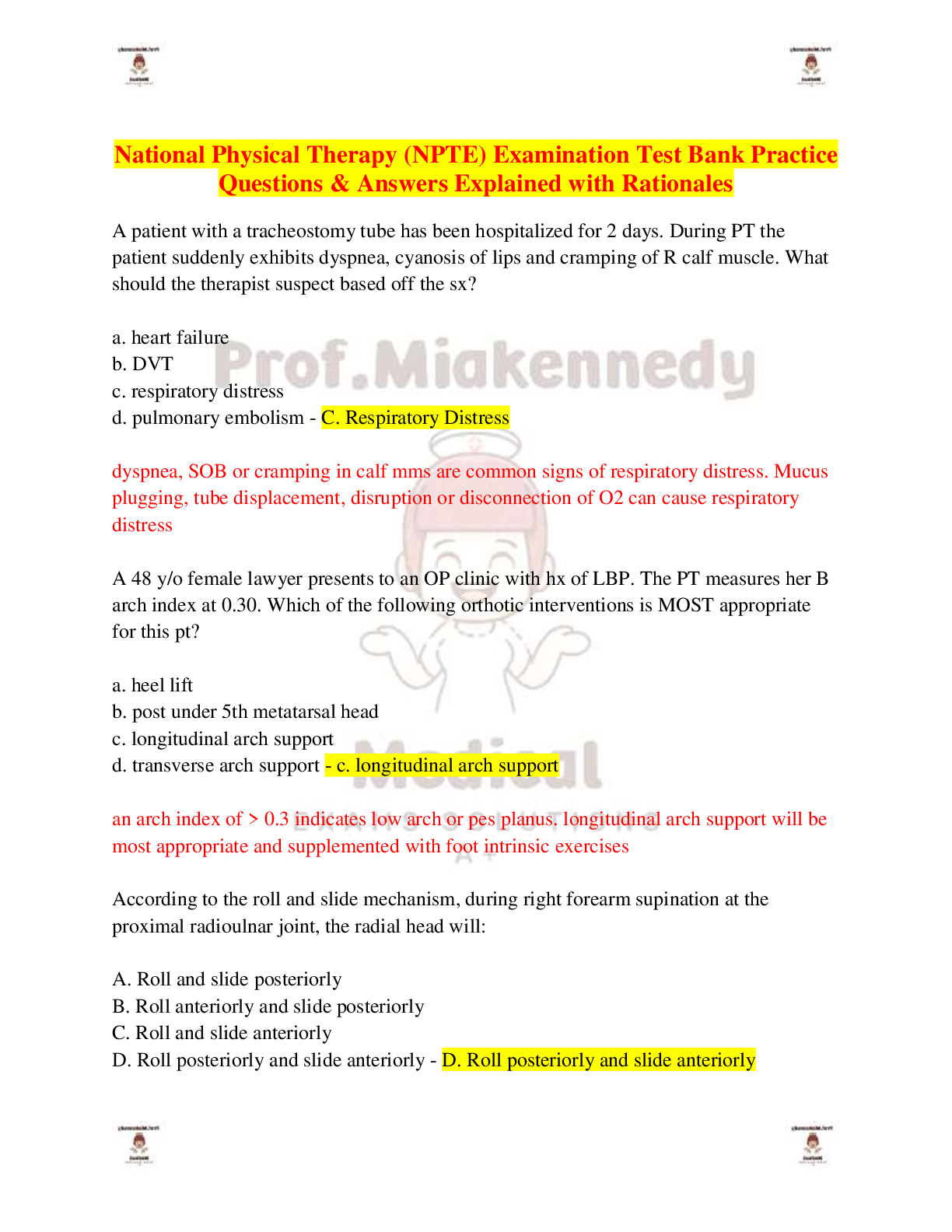

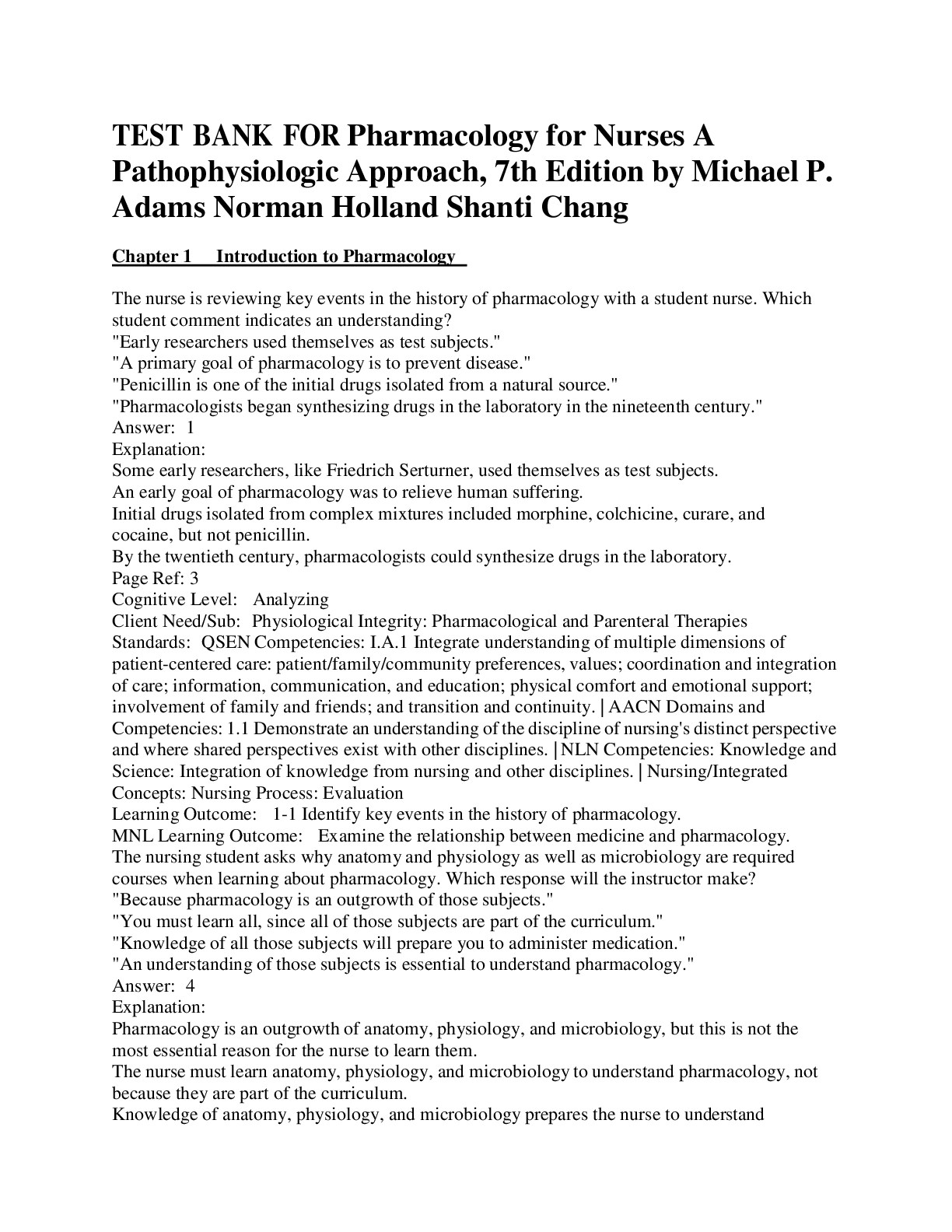

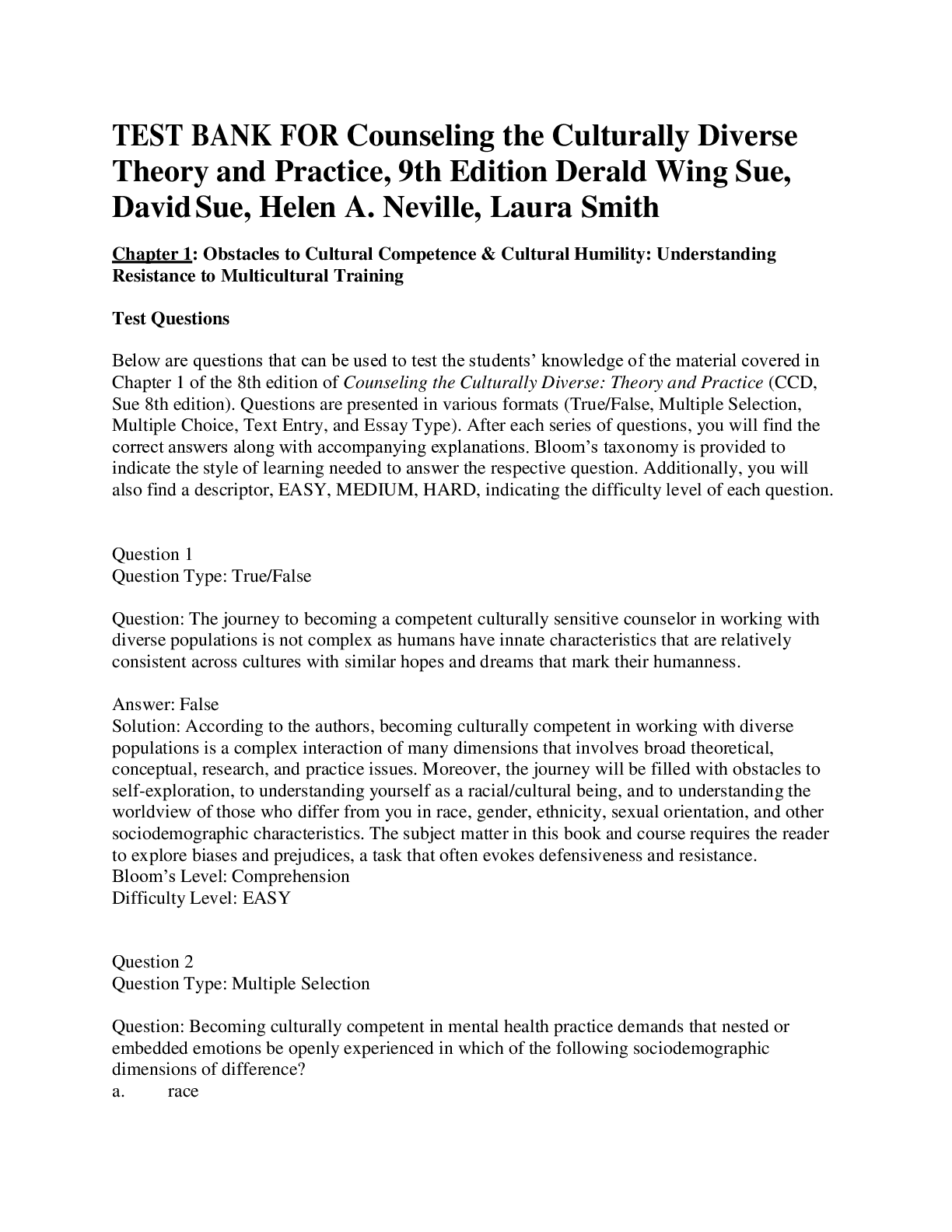
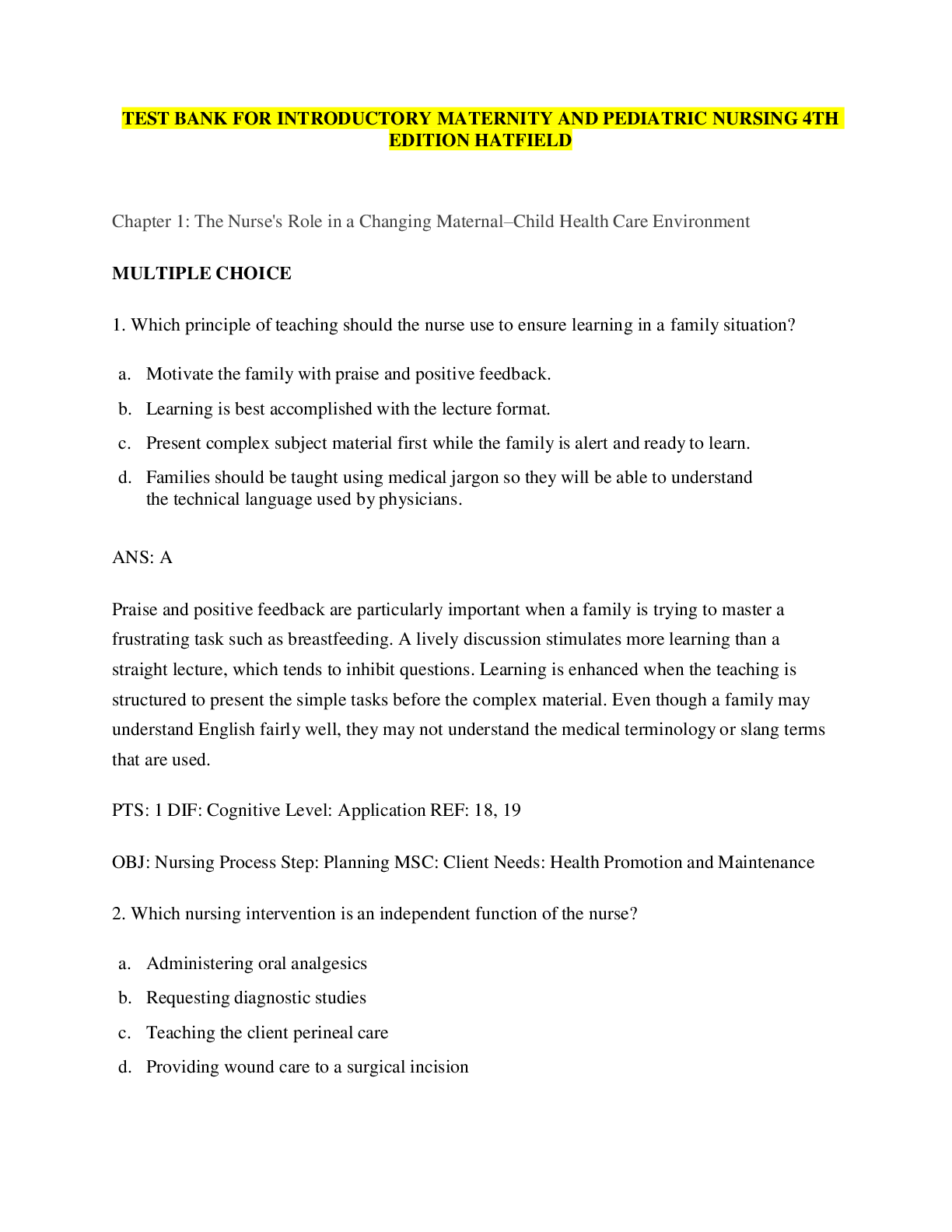


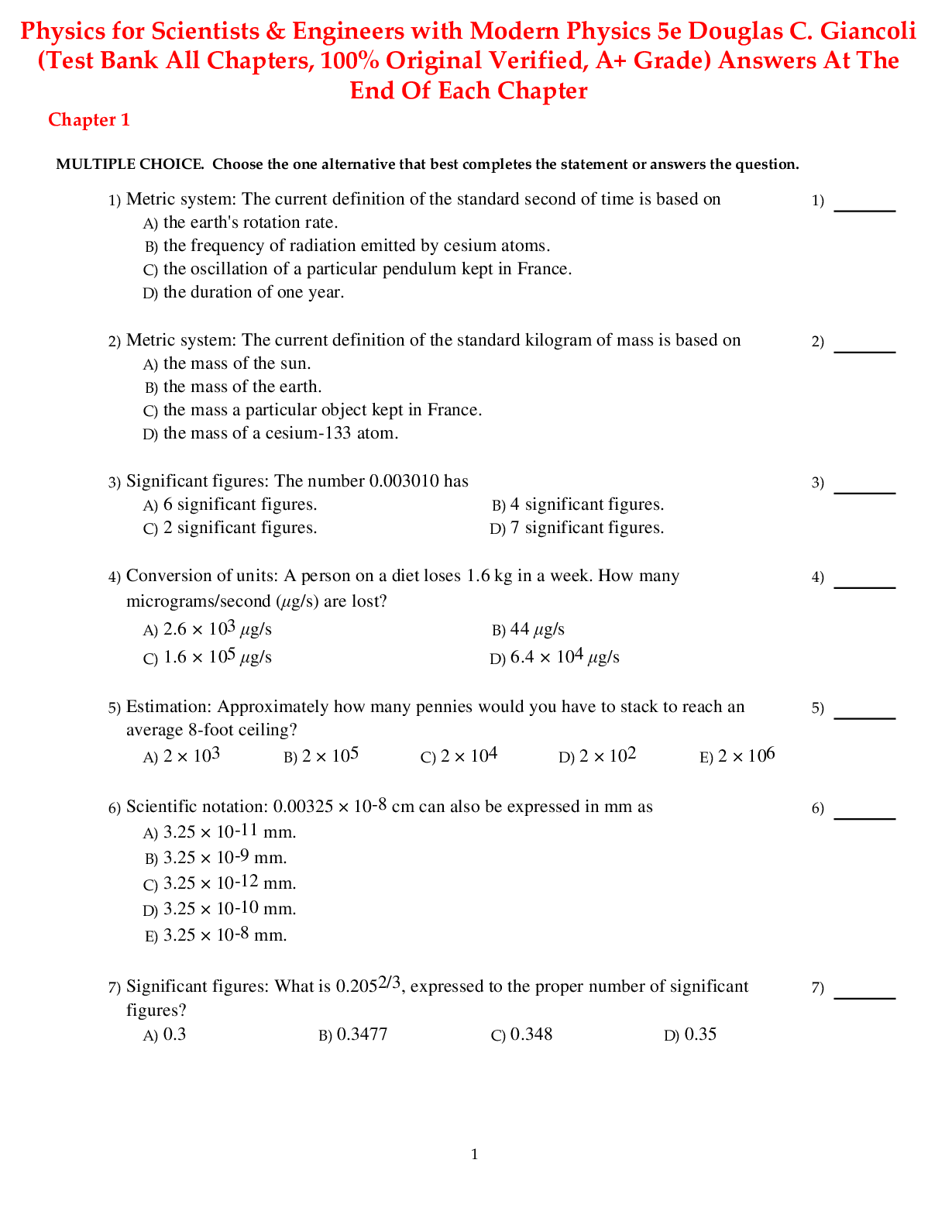
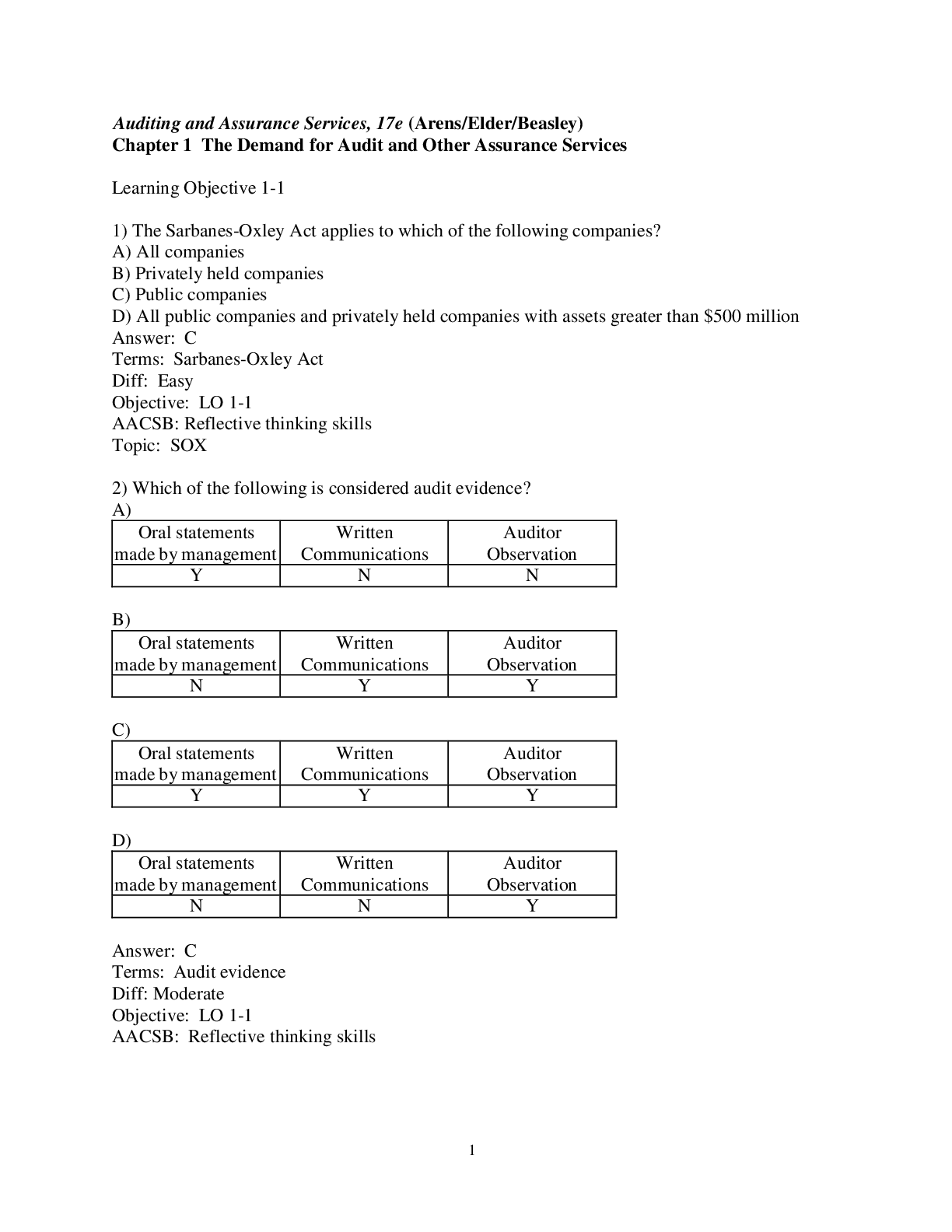
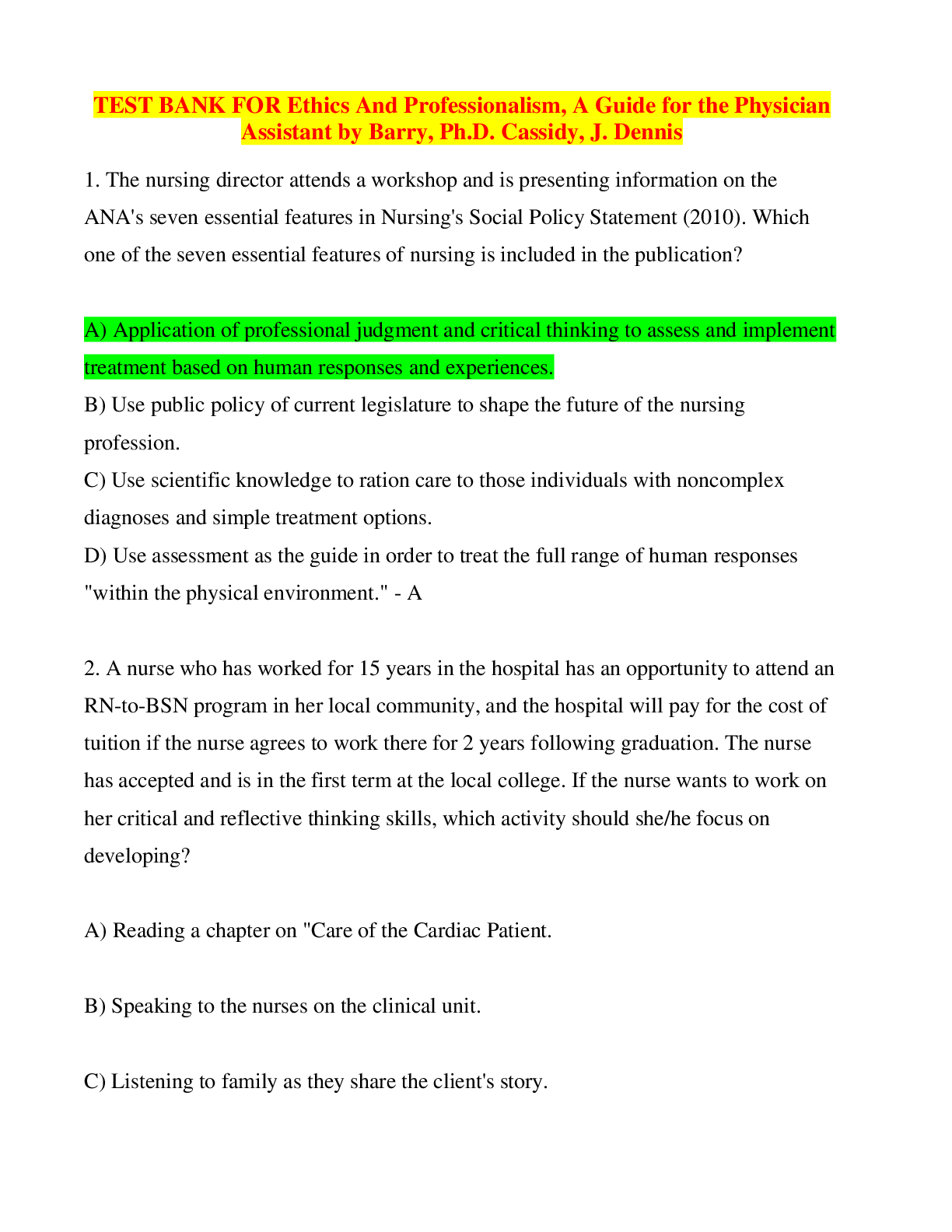




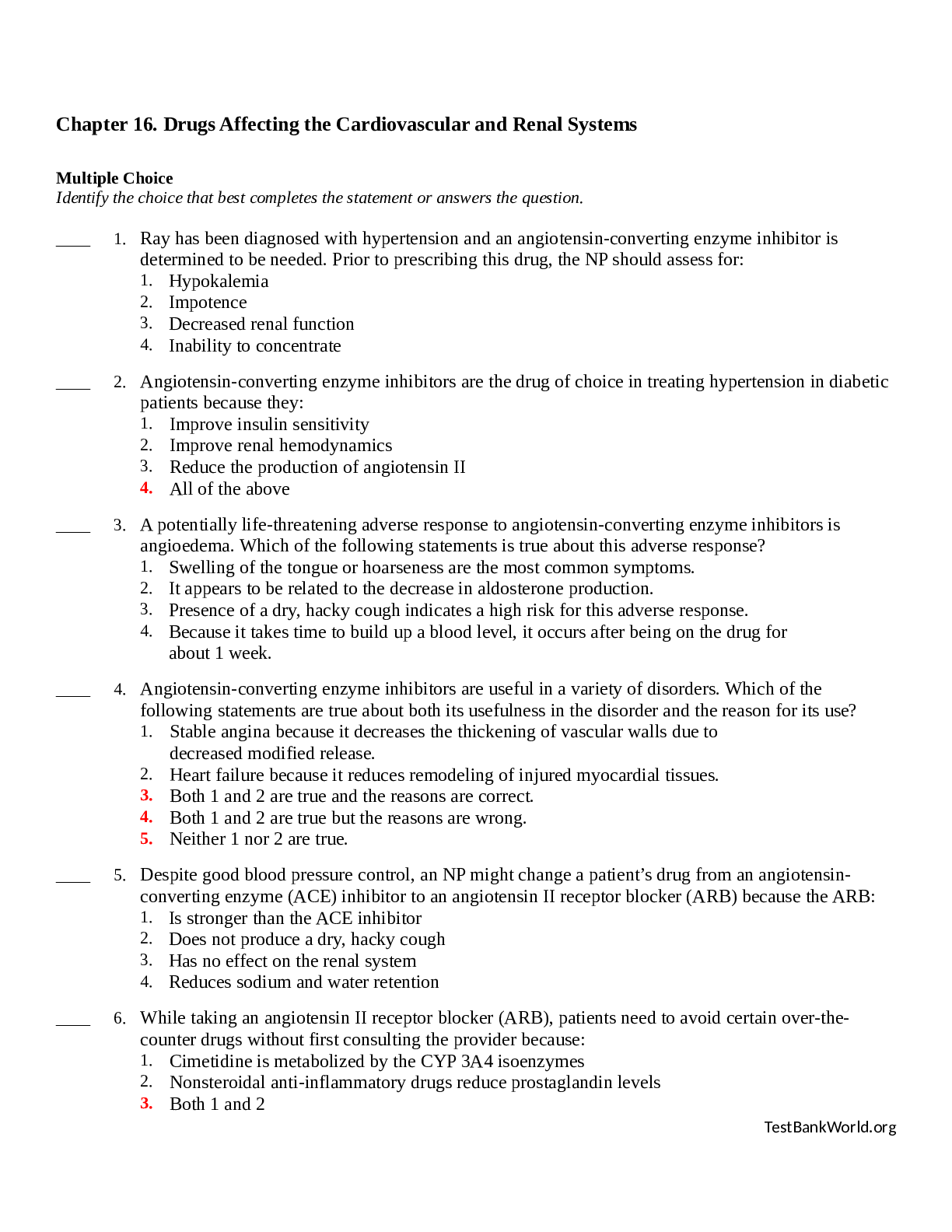
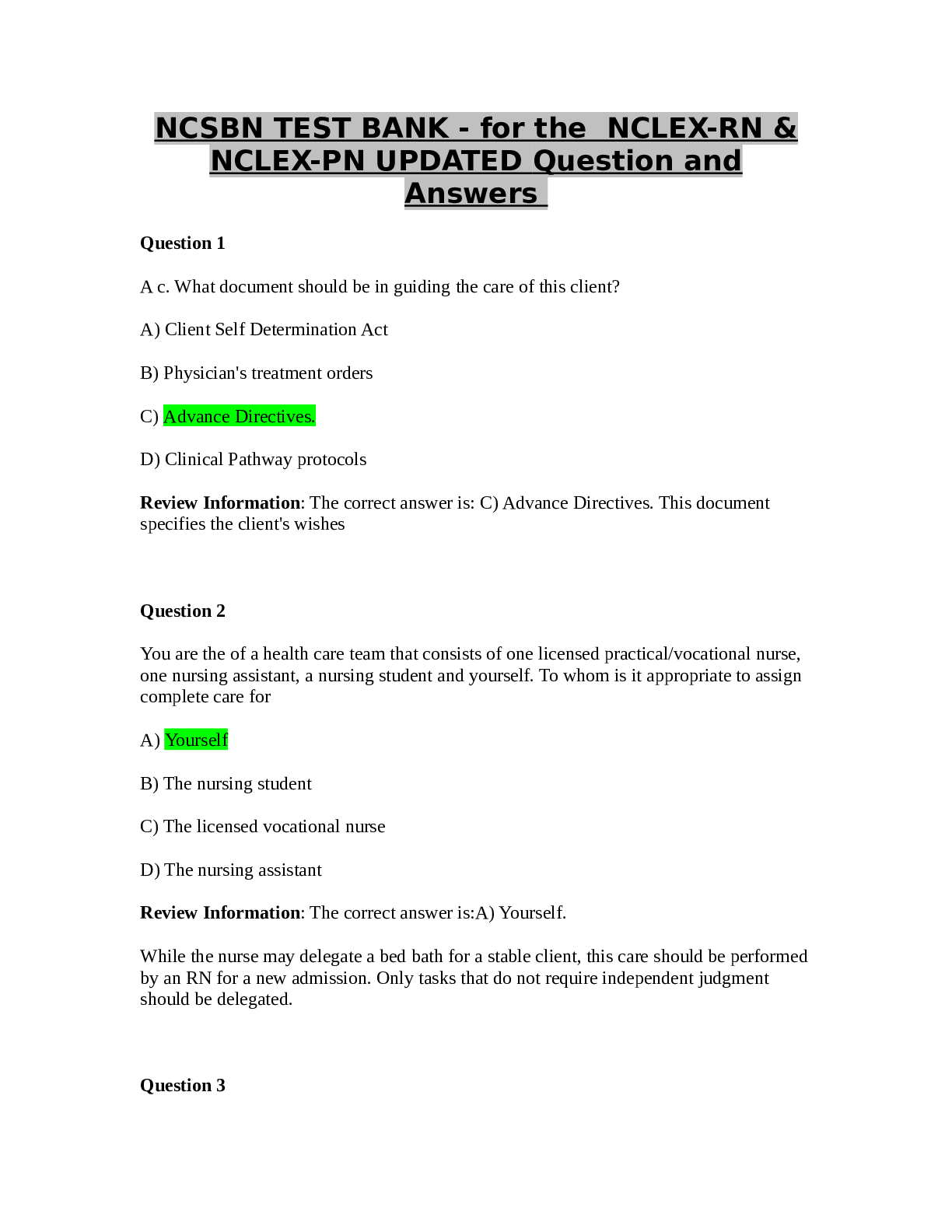

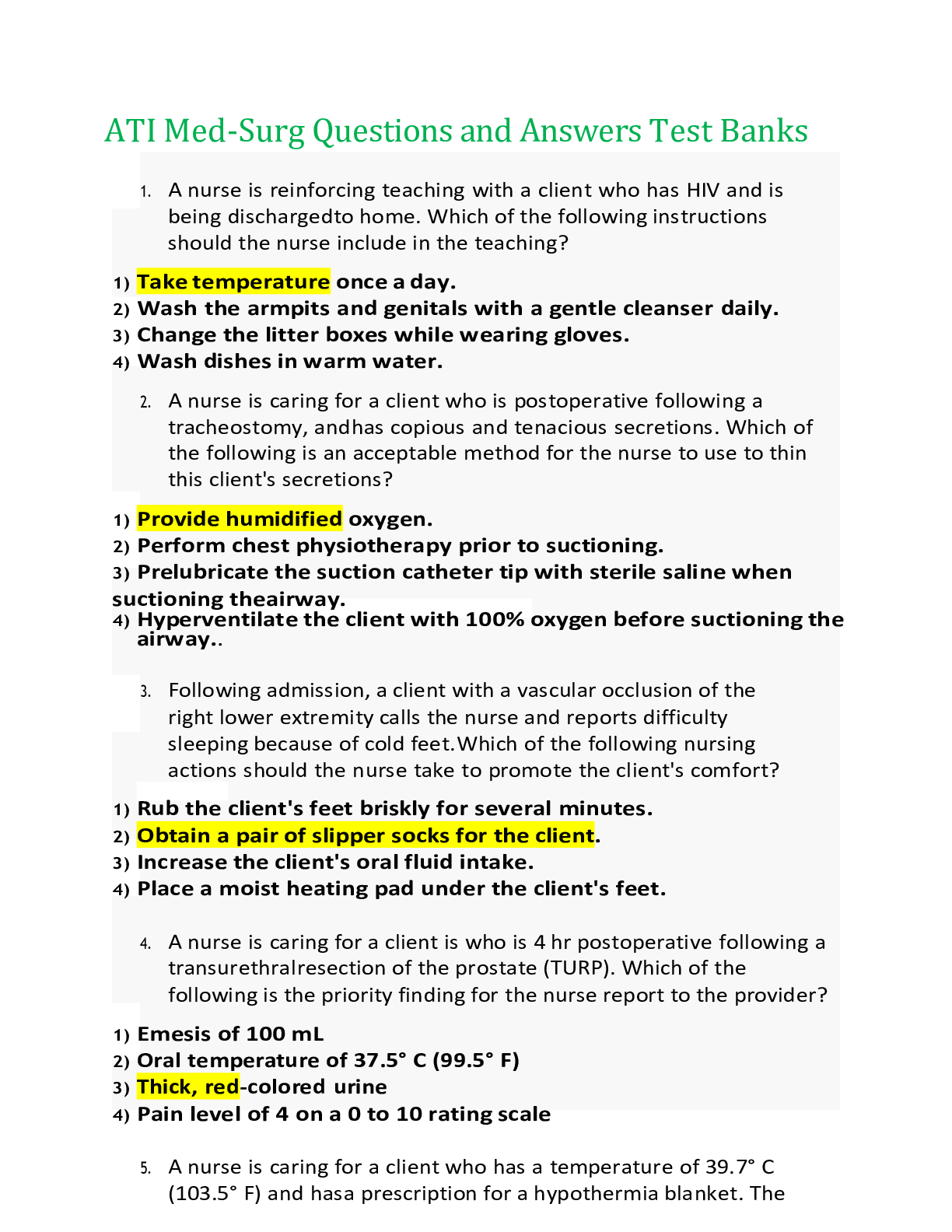
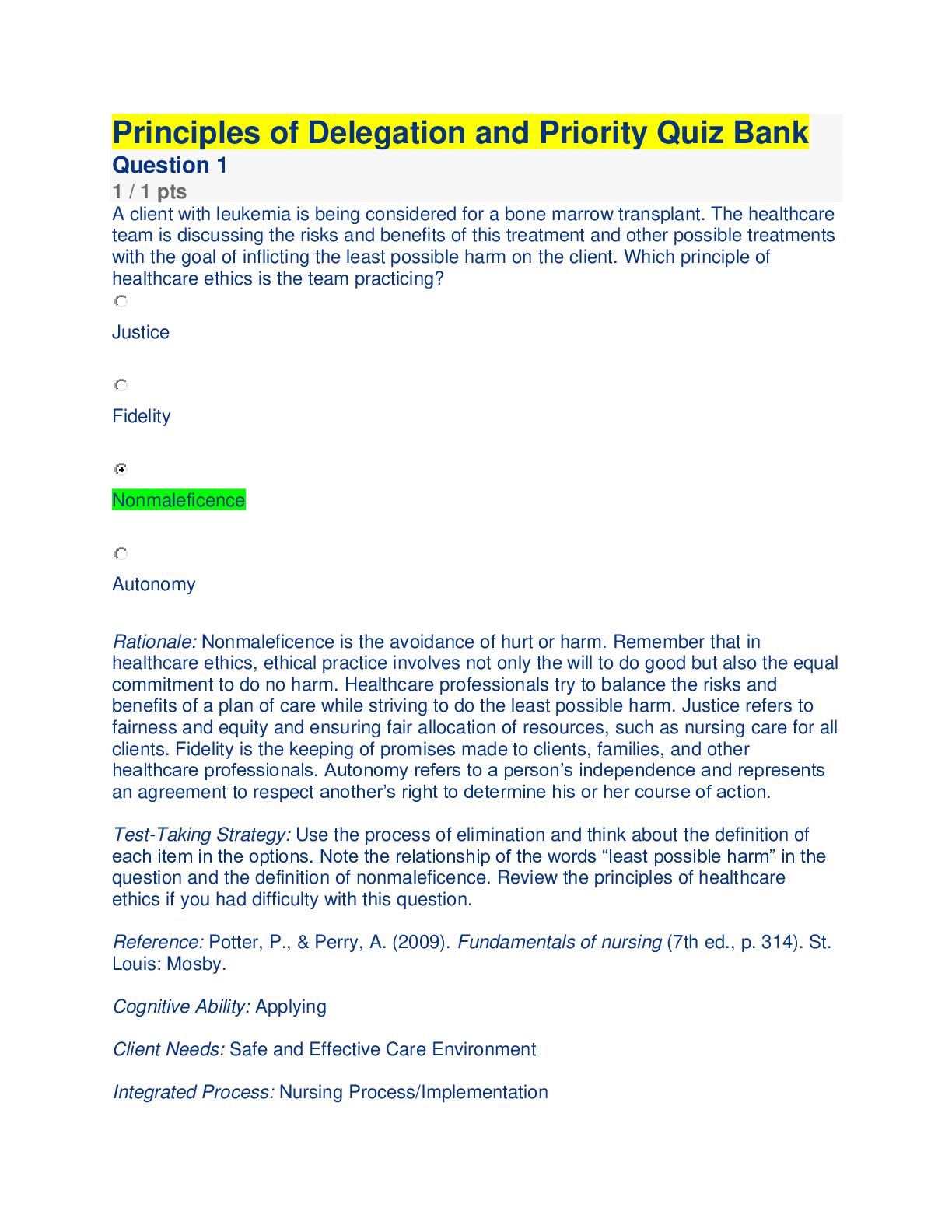

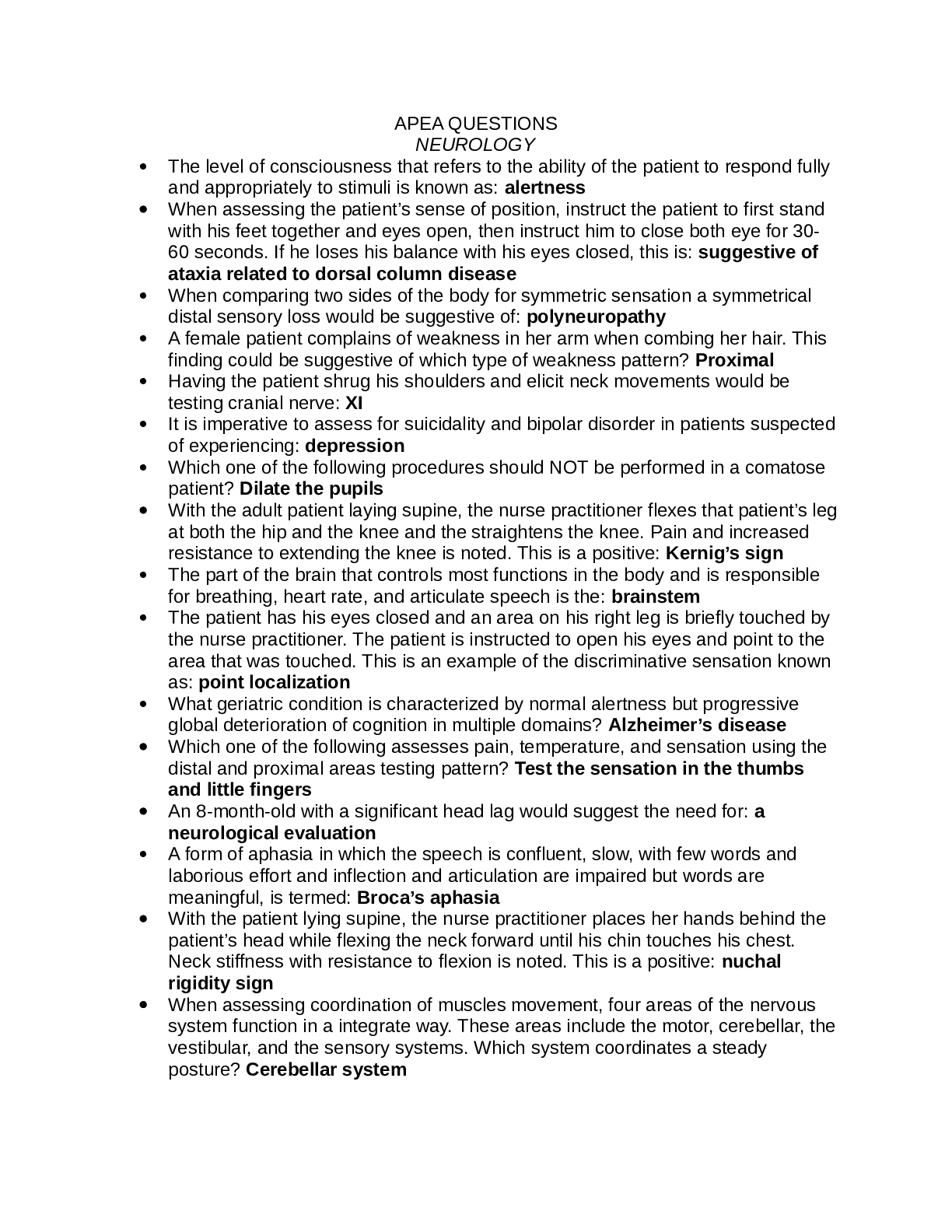

.png)



